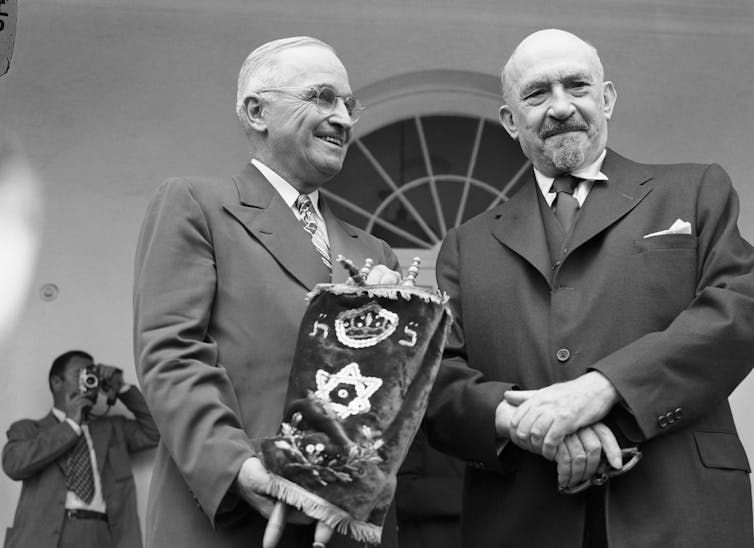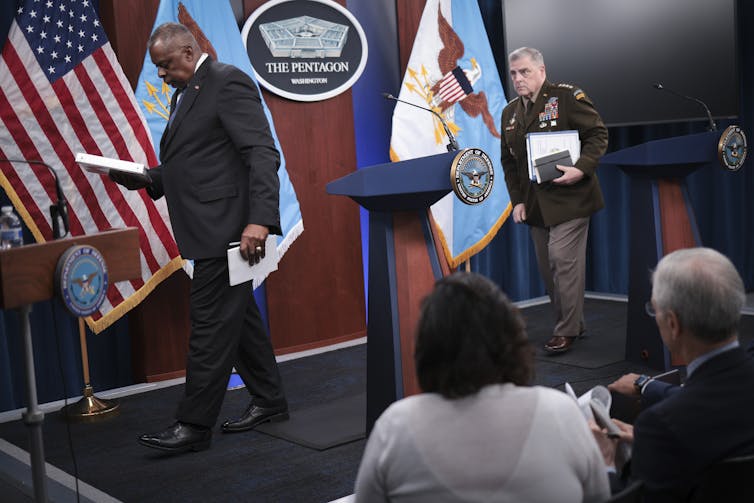
In his first remarks after the Oct. 7, 2023, Hamas attacks on Israel, President Joe Biden affirmed the United States offered “rock solid and unwavering” support to Israel, “just as we have (done) from the moment the United States became the first nation to recognize Israel, 11 minutes after its founding, 75 years ago.”
Vowing to destroy Hamas, Israel has launched a war on Gaza that as of the end of November had killed more than 14,000 Palestinians. The fighting has also destroyed much of Gaza and displaced about 70% of its population.
Israel, with U.S. backing, has not heeded calls for an immediate cease-fire or U.N. demands to stop targeting civilians. The Biden administration appears to have played a key role in negotiating a temporary truce and an exchange of hostages and prisoners between Israel and Hamas.
I teach courses on Middle East politics and the Arab-Israeli conflict, which includes the interconnected Israeli-Palestinian conflict and the conflict between Israel and Arab states. The roots of the U.S.-Israel relationship predate 1948 and provide context for what has long been characterized as a “special” relationship between the two countries – one that now appears crucial to Israel’s prosecution of a war in Gaza.
During the Cold War, it was the perception in the U.S. that Israel’s strategic value served as justification for the special relationship. While Israel has its own interests regarding the Arab-Israeli conflict, a supportive Congress and American domestic lobbyists have presented them as consistent with those of the U.S.
The Bible, Christian Zionism, popular culture, memorialization of the Holocaust after 1967 and the shared approach in the U.S. and Israel toward the land and the indigenous populations have all led to the transformation of Jews and Israelis from “outsiders” to “insiders” in the U.S.
This cultural and political affinity is behind the U.S.’s current unconditional support for Israel, as well as the fact that the U.S. is seen in the region and beyond as deeply implicated in Israel’s actions.
But since President Harry Truman recognized Israel in 1948, presidential policies show that the U.S.-Israel relationship has not always been “rock solid.”
Pre-statehood: The United States and Zionism
With an Arab majority for more than a millennium until 1948, the territory then called Palestine was part of the Ottoman Empire from 1517 until Britain captured it during World War I.
The Zionist movement achieved a major objective in November 1917, when Britain, for strategic and religious reasons, issued the Balfour Declaration in support of a national home for the Jewish people in Palestine. U.S. President Woodrow Wilson endorsed both this declaration and the League of Nations-sanctioned British administrative power over Palestine.
In Palestine, Britain used its administrative power, under what was called the Mandate over Palestine, to advance the Zionist project. The rise of Hitler and U.S. entry into World War II led American Zionists in 1942 to adopt the Biltmore Program, which called for unrestricted Jewish immigration to Palestine and for turning the territory into a Jewish state. The revelation of the full scale of Nazi atrocities boosted U.S. support for Zionism, effectively shifting the center of political Zionism from London to Washington.
The 1944 Democratic Party platform backed the “opening of Palestine to unrestricted Jewish immigration and colonization” and the creation of a Jewish state. But fearing damage to U.S. war efforts, President Franklin Roosevelt wrote to several Arab governments shortly before his death in 1945 that no action toward Palestine would be taken “which might prove hostile to the Arab people.”
Israel, the United States and the Cold War
President Harry Truman was sympathetic to Zionism because of his evangelical Christian upbringing. He endorsed the 1947 U.N. Partition Plan for Palestine to create an Arab state and a Jewish state and, despite opposition from within the administration, recognized the State of Israel on May 14, 1948.
Truman, however, refused to send weapons to either side of the 1948 Arab-Israeli War, because he viewed the conflict as a source of instability in the face of the emerging communist threat. In that war, 750,000 Palestinians fled or were expelled, becoming refugees from the land that became Israel.
President Dwight Eisenhower also sought to prevent Soviet penetration into the Middle East and attempted to maintain impartiality toward the Arab-Israeli conflict. He even threatened to cut off all official and private aid and to expel Israel from the U.N. to force Israel’s withdrawal from Egyptian territory, the Sinai, in 1957.
The conflict and US-Israeli special relationship
President John F. Kennedy coined the term “special relationship” about the two countries’ connection. He hoped that in exchange for U.S. defensive weapons, Israel would support his plan, based on U.N. Resolution 194, which called for repatriation or compensation for the Palestinian refugees and allow effective inspections of its nuclear program. Israel accepted the weapons but refused to cooperate on the other issues, neither of which was discussed again.
President Lyndon Johnson viewed Israel as a strategic asset and sent it advanced offensive weapons. Johnson supported Israel’s attack on Egypt, Syria and Jordan in the June 1967 war, when Israel first occupied the West Bank and Gaza Strip. Johnson also endorsed the November 1967 U.N. Resolution 242, which conditioned Israeli withdrawal on Arab states’ recognition of, and entering into peace treaties with, Israel. Israel’s swift victory transformed the U.S.-Israeli relationship, elevating Israel into a critical component of American Jewish identity and solidifying pro-Israel policies in Washington.
President Richard Nixon provided Israel with a massive increase in military and economic aid because he accepted uncritically Israel’s claim that the Soviets were the main cause of tension in the Middle East, and because of the 1973 Arab-Israeli War. Generous aid packages have since become routine: In recent years, U.S. aid to Israel has been about US$3 billion to $4 billion annually, totaling almost $318 billion since World War II, including the value of weapons.
While President Jimmy Carter brokered the 1979 Egyptian-Israeli peace treaty, the Ronald Reagan administration later moved away from an active peace process and, within a Soviet-centered focus, signed with Israel memoranda on strategic cooperation, elevating the relationship to a new strategic level. The administration supported Israel’s 1982 invasion of Lebanon, refused to label West Bank settlements as illegal, concluded with Israel and the U.S.’s first free trade agreement and designated Israel in 1987 “a major non-NATO ally.”
President Bill Clinton brokered the Oslo Accords, in which Israel agreed to withdraw from areas in the West Bank and Gaza Strip and cede some control to a new political entity, the Palestinian Authority. But Clinton failed to achieve a permanent Palestinian-Israeli agreement, and his administration, according to one U.S. negotiator, acted as “Israel’s attorney, catering and coordinating with the Israelis at the expense of successful peace negotiations.”

The ‘peace process’ and the ‘war on terrorism’
In the wake of 9/11, President George W. Bush accepted Israel’s narrative that it was waging its own war on terrorism and its condition that a change of Palestinian leadership must precede any further negotiations. But neither Bush’s call for a Palestinian state nor the 2005 election of Mahmoud Abbas as president of the Palestinian Authority led to an agreement.
In 2006, the Bush administration pushed for, and endorsed the participation of Hamas in, Palestinian legislative elections. When Hamas won and formed a new government, both Israel and the U.S. refused to deal with it, imposed sanctions on the Palestinian Authority and worked to widen the split between Hamas and Abbas’ Fatah party. Bush even supported a covert plan to spark civil war between Palestinians, which in fact led to a Hamas-Fatah military confrontation. That fight ended with Hamas’ takeover of Gaza, which led Israel to impose a blockade on Gaza in 2007.
President Barack Obama supported Israeli attacks on Gaza, which failed to eliminate Hamas’ military threat. Diplomatically, Obama was reluctant to get directly involved, while Israel continued to refuse to permanently freeze settlement building.
President Donald Trump’s Abraham Accords and the recent discussions under the Biden administration to establish Israeli-Saudi diplomatic relations assumed that the Arab-Israeli conflict could be solved without solving the Palestinian conflict. But the current war challenges such an assumption and illustrates that current U.S. support for Israel is indeed “rock solid and unwavering.”
Fayez Hammad, Lecturer in Political Science and International Relations, USC Dornsife College of Letters, Arts and Sciences
This article is republished from The Conversation under a Creative Commons license.


 With 92% of customers expressing some level of concern about inflation, according to Walmart’s Holidays 2023 Seasonal Survey, it’s important to take steps to save time and money during an expensive time of year.
With 92% of customers expressing some level of concern about inflation, according to Walmart’s Holidays 2023 Seasonal Survey, it’s important to take steps to save time and money during an expensive time of year.



 Myth: A traditional down-to-studs remodel is the “right” way or “only” way to achieve a new bathroom.
Myth: A traditional down-to-studs remodel is the “right” way or “only” way to achieve a new bathroom. If you've lived in your home for a while, it may be time to give your bathroom more than just a facelift. Dated fixtures, peeling paint and chipped tiles are telltale signs that all isn't well with your bathroom. A beautiful new bathroom may be more accessible than you think.
If you've lived in your home for a while, it may be time to give your bathroom more than just a facelift. Dated fixtures, peeling paint and chipped tiles are telltale signs that all isn't well with your bathroom. A beautiful new bathroom may be more accessible than you think. 








 Regularly bathing your dog removes dirt, dander, debris and odors, and can help clear irritation-causing allergens. However, bathing too frequently removes natural oils, which keep skin supple and the coat soft and pliable. For best results, use a high-quality pet shampoo that’s gentle on the skin and coat then follow up with a nourishing conditioner for smooth, shiny fur.
Regularly bathing your dog removes dirt, dander, debris and odors, and can help clear irritation-causing allergens. However, bathing too frequently removes natural oils, which keep skin supple and the coat soft and pliable. For best results, use a high-quality pet shampoo that’s gentle on the skin and coat then follow up with a nourishing conditioner for smooth, shiny fur.




 Connecting people more closely with nature and natural elements, biophilic design can lead to increased well-being and productivity. Growing wellness and environmental concerns are driving demand for outdoor living space improvements and integration of nature in design, including elements like green roofs, living walls and large windows.
Connecting people more closely with nature and natural elements, biophilic design can lead to increased well-being and productivity. Growing wellness and environmental concerns are driving demand for outdoor living space improvements and integration of nature in design, including elements like green roofs, living walls and large windows.


